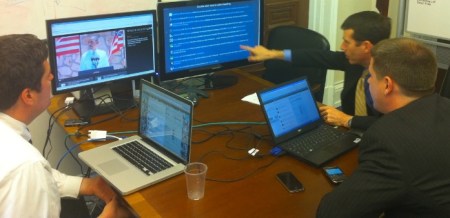In the more-fun-to-read, newsstand magazine this week, I have a piece about White House efforts to be more online, including a scene from last week (pictured above, courtesy of the White House) when message man David Plouffe (pointing) watched Twitter, while President Obama spoke in Texas about immigration. Here are some more thoughts on how social networks are sure to change politics and the White House going forward.
Every day at the White House, senior aides get sent an email called “Web Trends” that give a simple snapshot of what is happening online, with a list of popular Google searches, Twitter trends and popular pages on WhiteHouse.gov. This information is digested by communications staff along with the hundreds of standard news clips that White House officials receive–everyone say hello to Dan Pfeiffer, who is probably reading this in his email–and other reports on the sorts of language that people are using. Suffice it to say, the White House still has plenty of room to grow its online data gathering, and in the coming months and years, it almost certainly will.
Companies like Nielson now sell access to far more detailed ways of monitoring and tracking what people are talking about on Social Networks and how they are talking about it. It is almost a certainty that the 2012 general election campaigns will sign up for these services, allowing senior staff to see how their candidates are doing in real time on Twitter or Facebook, without having to sit in front of a screen to watch it all happen.
Politico’s Ben Smith fretted Thursday that my article suggested that the White House was abandoning formal focus groups for Twitter hash tags. But as White House Communications Director Pfeiffer explains (on Twitter of course) that’s not the point. Social networks are where a significant and growing percentage of the population get their information, and so organizations that need to communicate need to understand how to communicate in social networks. At the White House, where social networks were blocked for security reasons at the beginning of the Obama presidency, staff are working to make up for lost time.
Despite all the data produced by online traffic, nailing down the exact power of social networks online is still a work in progress. In my article, Plouffe pointed to the number of people who watched President Obama’s Sunday night Osama bin Laden announcement as a clear sign of the potential. The number was huge, 56.5 million, bigger than any other Obama presidential address. According to data Nielson gave TIME, 54% of the people watching television in the U.S. between 11:30 and 11:45 p.m. on May 1 were watching one of the nine channels that broadcast the President’s address. The total U.S. television audience was about 106 million.
Before the news leaked, between 9 and 10 p.m., the total audience of Americans watching television was slightly bigger, at about 120 million. But the Nielson numbers show far less focus: Between 9 and 10 p.m., Nielson recorded only 28.3 million people watching the nine networks that would later broadcast the speech. That means that in the course of two hours, the audience for the channels that broadcast the speech nearly doubled, even as millions of people turned off their televisions and went to bed. Some people no doubt found out about the bin Laden killing by flipping the channel. Some called their friends. But few doubt that social networks, both online and offline, played a huge, if hard to define, role as well.
As the event unfolded, for example, Twitter was publishing about 5,000 tweets per second, its highest sustained rate of traffic ever, according to Mashable. According to one count, there were nearly 28 million tweets sent in just two hours and 35 minutes. Another tracking firm, Sybase365, found an 18 percent increase in SMS traffic (cell phone text messaging) when news of bin Laden’s death broke. For communications staffs in the corporate, marketing and political worlds, figuring out how to activate these networks is the mother lode. And this is the reason Plouffe watches Twitter when Obama speaks.
(In the photo above, from left to right, White House Director of Digital Strategies Macon Phillips, Senior Advisor David Plouffe and Communications Director Dan Pfeiffer.)

